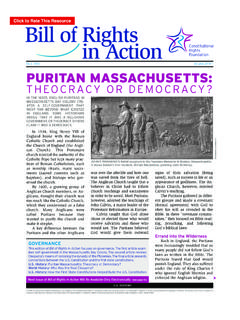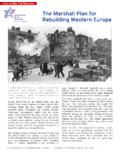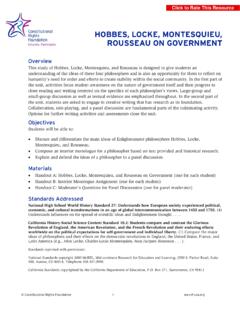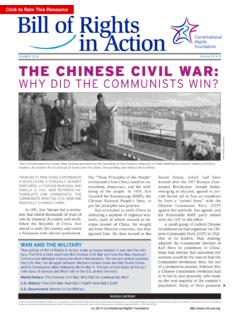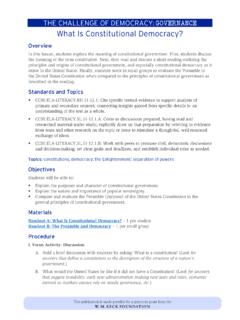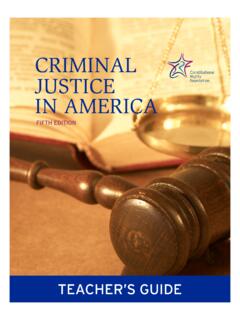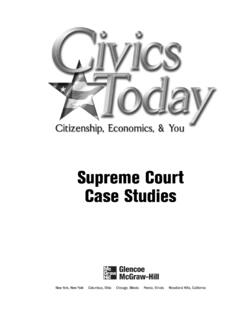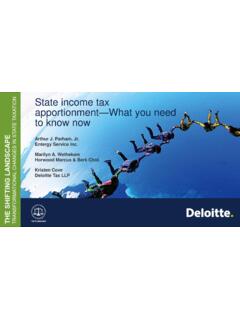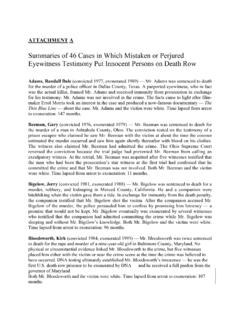Transcription of Fugitive Slave Law of 1850 - Constitutional Rights Foundation
1 BRIA 34:2 (WINTER 2019) HISTORYIn 1850, Southerners succeeded in getting a new federal lawpassed to return Fugitive slaves who had escaped to the government enforced this law, but some Northernstates passed laws to resist it. Sometimes, free blacks and sym-pathetic whites joined to rescue captured Fugitive idea of returning Fugitive slaves to their own-ers originated at the Constitutional Convention in1787. At that time, the Constitution stated:No Person held to Service or Labor in one State,under the Laws thereof, escaping into another,shall, in Consequence of any Law of Regulationtherein, be discharged from such Service or Labor,but shall be delivered up on Claim of the Party towhom such Service or Labor may be due. ( art. IV, sec. 2, cl. 3)Nearly all the states in 1787 held that slavery waslegal. But Northern states soon began to outlaw it andprovide refuge for escaping slaves. This promptedSouthern Slave owners to demand a law by Congressto enforce the provision in the Constitution that re-quired the return of escaped persons held to Serviceor Labor, in other words, Fugitive slaves.
2 In 1793, Congress passed the first Fugitive SlaveLaw. This law left it mainly up to the Slave ownersand their hired Slave catchers to capture and returnrunaway slaves. In the meantime, free blacks and anti-slaverywhites organized a Slave -escape system that came tobe called the Underground Railroad. This involved es-cape routes, houses for hiding, and guides called conductors to help escaping slaves reach refuge inthe North. Probably the most famous Underground Railroadconductor was Harriet Tubman. She escaped slaveryherself in 1849. Then she repeatedly returned to theSouth to guide about 70 slaves to freedom. I was free,and they should be free, she argued that once slaves touchedthe soil of a non- Slave state, they were free. SomeNorthern states prohibited county sheriffs from as-sisting Slave hunters or allowing county jails to holdtheir captives. In 1842, the supreme court in Prigg v. Pennsylvania found the Fugitive Slave Law of 1793constitutional.
3 However, enforcement of the law wasthe responsibility of the federal government, held thecourt, not the states. The supreme court also decidedthat Slave holders had the complete right and title ofownership in their slaves, as property, in every statein the union into which they might escape.. This ruling stiffened abolitionist resistance to theFugitive Slave Law. Southerners intensified their de-mands for stronger federal enforcement of it. The New Law in 1850 After the Mexican-American War ended in 1848,the acquired vast new territories in the Westcalled the Mexican Cession. This re-opened the issueof the expansion of slavery west of the MississippiRiver. The Missouri Compromise of 1820 had seem-ingly settled this matter. It barred slavery north of aline of latitude that now included part of the MexicanCession. Southerners now wanted these lands opento Congress, Henry Clay, representing the South,and Daniel Webster, representing the North, reacheda compromise that was signed into law by PresidentMillard Fillmore on September 18, 1850.
4 The Northgot the admission of California to the Union as a freestate and abolition of the Slave trade in the District ofWikimedia CommonsTHE FUGITIVESLAVE LAWOF 1850 Senator Henry Clay of Kentucky introducing the Compromise of 1850 in the United States The South, under the concept of popularsovereignty, got a provision that allowed the voters inthe new Utah and New Mexico territories to decide ifthey would be free or Slave . The South also got a newFugitive Slave main difference between the new FugitiveSlave Law and the one enacted in 1793 was that thefederal government would play a much more activerole in returning escaped slaves to their masters. Keyto the new process were commis-sioners appointed by federal judges. Commissioners and federaljudges had the authority to issuewarrants to Slave owners, slavecatchers, or U. S. marshals to arrestsuspected Fugitive slaves. However,no arrest warrants were required,and accused escaped slaves could beseized without them.
5 The Fugitive Slave hunters had the right to demandthe help of marshals. In addition, the law statedthat all good citizens are hereby commanded to aidand assist in the prompt and efficient execution of thislaw. Any person who interfered with an arrest, at-tempted a rescue, or aided or hid a Fugitive Slave wasliable for a $1,000 fine and up to six months in jail. Once in federal custody, a person accused of beinga Fugitive Slave was taken before a commissioner fora hearing to determine proof of his or her identity asan escaped Slave . This was usually provided by an af-fidavit that had been sworn under oath by the Slave sowner in the court of the county from where the slavehad escaped. The affidavit described the Fugitive slaveand the circumstances of his or her escape. At thehearing, the law prohibited the accused Fugitive slavefrom testifying in his or her own before commissioners often lasted justminutes. If the identity of the person as an escapedslave had not been proven, the commissioner wouldorder the person s release and collect a fee of $5.
6 Ifthe person s identity had been proven, the commis-sioner would issue a certificate, authorizing the fugi-tive Slave s removal to his or her owner, and collect afee of $ the Slave owner or his agent wouldtransport the Slave back to the South. If there was ev-idence of an attempt to rescue the Slave , the commis-sioner could order the marshal to hire as manypersons as necessary to return the Slave at the expenseof the government. Fugitive Slave RescuesThe first year of the new Fugitive Slave Law s op-eration caused much turmoil among Northern freeblacks and abolitionist whites. They especially hatedthe provision that required ordinary citizens to aid inthe capture of Fugitive slaves. Many Northern cities formed biracial VigilanceCommittees to alert Fugitive slaves about the presenceof Slave hunters. Some black communities formedarmed this time, Boston was the center of anti-slaveryagitation in the country. It was here that the firstwidely publicized Fugitive Slave rescue occurred.
7 OnFebruary 15, 1851, Slave catchers captured ShadrachMinkins at a restaurant where he was a waiter. He hadescaped slavery from Virginia the previous by most as Shadrach, the Slave catcherstook him to a commissioner for ahearing. But before the hearinggot underway, about 20 blackmen barged into the courtroomand carried him away. They hidhim until sending him on to free-dom in Canada. It was a colony ofBritain that had abolished slaveryin s surprising rescue caused celebrationin the North and rage in the South. PresidentFillmore and his secretary of state, Daniel Webster,signed a proclamation, warning against MOB LAW and accusing the rescuers of treason. Some of therescuers were arrested and put on trial but none wereever 34:2 (WINTER 2019) HISTORYAn 1851 abolitionist poster warning escaped slaves in Boston to be-ware of police officers and others authorized to act as Slave was in Bostonthat the first widelypublicized fugitiveslave rescue CommonsBarely two months later, Thomas Sims was ar-rested and taken to the Boston courthouse for hishearing.
8 Outside, abolitionists addressed crowds ofblacks and whites. The state militia was ordered toprotect the courthouse. Meanwhile, the VigilanceCommittee met to plan a rescue. But this time the gov-ernment was prepared. When the commissioner or-dered Sims returned to his owner in Georgia,hundreds of state militiamen marched him to a fed-eral ship that took him to September 1851, Maryland Slave owner Ed-ward Gorsuch led a posse into Pennsylvania to cap-ture his four escaped slaves. He secured an arrestwarrant from a commissioner in Philadelphia plusthe aid of a s posse tracked two of the slaves to Chris-tiana, where they had been hidden in the home of ablack abolitionist, William Parker. When Gorsuch pre-sented his warrant, Parker refused to let him and hismen enter the house. Parker s wife then blew a hornfrom a window, alerting neighbors of the attempt to cap-ture the fugitives. The posse fired their guns at her. Soon, armed black neighbors and some whites ar-rived at the scene, outnumbering the posse.
9 Most ofthem began to retreat, but Gorsuch refused to leave. Iwant my property and I will have it! he yelled. In theresulting confusion, Gorsuch was shot and killed,probably by one of his former slaves. Parker, his wife,and the fugitives then fled to violence shocked even abolitionists. Local,state, and federal law enforcement and a unit of made mass arrests of blacks suspected of par-ticipating in the Christiana riot. They were accusedof treason, but none were of the most spectacular rescues occurred onemonth later in Syracuse, New York, where an anti-slavery convention happened to be meeting. JerryHenry had escaped slavery from Missouri severalyears earlier. A marshal arrested and took Jerry,as he was commonly called, in handcuffs to a com-missioner for his Fugitive Slave hearing. Word spread quickly and crowds, consisting ofblack and white supporters, gathered outside and in-side the courthouse. In the commotion, Jerry boltedout of the courtroom still in handcuffs, but he wassoon caught by local police.
10 Jerry was taken to the po-lice station where the commissioner decided to re-sume the hearing. After the hearing was adjourned, Jerry was lockedup in the police station. Thousands had surroundedit, shouting for Jerry s release. Finally, an organizedband of black and white members of the Syracuse Vigilance Committee attacked the police station, over-whelmed guards, and used a battering ram to breakinto the room where Jerry was held. They took himout of the police station and then hid him in , they sent him through the Underground Railroad to Canada. authorities arrested dozens of suspected res-cuers and tried them for treason. Only one was con-victed, but he died before his appeal was heard. Therest were not convicted, or their cases were continued in several states but were commissioner hearing process proceeded with thebacking of federal force. Northern State ResistanceAt first there was widespread hostility against theFugitive Slave Law. But then public opinion in theNorth changed to support it.

